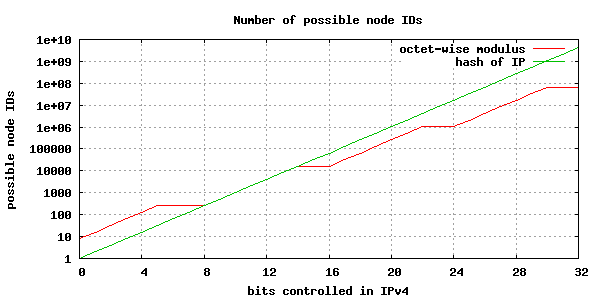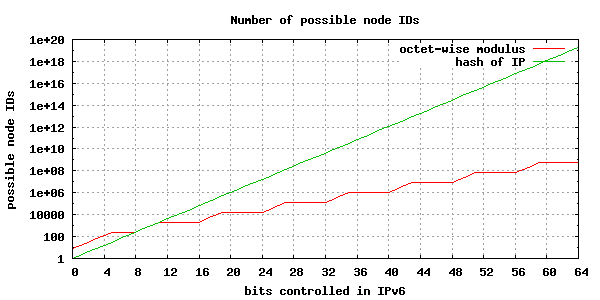BitTorrent DHT security extension
| Author: | Arvid Norberg, arvid@rasterbar.com |
|---|---|
| Version: | Draft |
Table of contents
BitTorrent DHT security extension
The purpose of this extension is to make it harder to launch a few specific attacks against the BitTorrent DHT and also to make it harder to snoop the network.
Specifically the attack this extension intends to make harder is launching 8 or more DHT nodes which node-IDs selected close to a specific target info-hash, in order to become the main nodes hosting peers for it. Currently this is very easy to do and lets the attacker not only see all the traffic related to this specific info-hash but also block access to it by other peers.
The proposed guard against this is to enforce restrictions on which node-ID a node can choose, based on its external IP address.
considerations
One straight forward scheme to tie the node ID to an IP would be to hash the IP and force the node ID to share the prefix of that hash. One main draw back of this approach is that an entities control over the DHT key space grows linearly with its control over the IP address space.
In order to successfully launch an attack, you just need to find 8 IPs whose hash will be closest to the target info-hash. Given the current size of the DHT, that is quite likely to be possible by anyone in control of a /8 IP block.
The size of the DHT is approximately 8.4 million nodes. This is estmiated by observing that a typical routing table typically has about 20 of its top routing table buckets full. That means the key space is dense enough to contain 8 nodes for every combination of the 20 top bits of node IDs.
2^20 * 8 = 8388608
By controlling that many IP addresses, an attacker could snoop any info-hash. By controlling 8 times that many IP addresses, an attacker could actually take over any info-hash.
With IPv4, snooping would require a /8 IP block, giving access to 16.7 million Ips.
Another problem with hashing the IP is that multiple users behind a NAT are forced to run their DHT nodes on the same node ID.
Node ID restriction
In order to avoid the number node IDs controlled to grow linearly by the number of IPs, as well as allowing more than one node ID per external IP, the node ID can be restricted at each class level of the IP.
The expression to calculate a valid ID prefix (from an IPv4 address) is:
sha1((A * (B * (C * (D * (rand() % 8) % 0x100) % 0x4000) % 0x100000)) % 0x4000000)
Where A, B, C and D are the four octets of an IPv4 address.
The pattern is that the modulus constant is shifted left by 6 for each octet. It generalizes to IPv6 by only considering the first 64 bit of the IP (since the low 64 bits are controlled by the host) and shifting the modulus by 3 for each octet instead.
The details of implementing this is to evaluate the expression, store the result in a big endian 32 bit integer and hash those 4 bytes with SHA-1. The first 4 bytes of the node ID used in the DHT MUST match the first 4 bytes in the resulting hash. The last byte of the hash MUST match the random number used to generate the hash.


Example code code for calculating a valid node ID:
uint8_t* ip; // our external IPv4 or IPv6 address (network byte order)
int num_octets; // the number of octets to consider in ip (4 or 8)
uint8_t node_id[20]; // resulting node ID
uint32_t rand = rand() & 0xff;
uint32_t modulus = 0x100;
uint32_t seed = rand & 0x7;
int mod_shift = 6 * 4 / num_octets; // 6 or 3, depending on IPv4 and IPv6
while (num_octets)
{
seed = (uint64_t(seed) * ip[num_octets-1]) & (modulus-1);
modulus <<= mod_shift;
--num_octets;
}
seed = htonl(seed);
SHA_CTX ctx;
SHA1_Init(&ctx);
SHA1_Update(&ctx, (unsigned char*)&seed, sizeof(seed));
SHA1_Final(&ctx, node_id);
for (int i = 4; i < 19; ++i) node_id[i] = rand();
node_id[19] = rand;
Example code to verify a node ID:
uint8_t* ip; // incoming IPv4 or IPv6 address (network byte order)
int num_octets; // the number of octets to consider in ip (4 or 8)
uint8_t node_id[20]; // incoming node ID
uint32_t modulus = 0x100;
uint32_t seed = node_id[19] & 0x7;
int mod_shift = 6 * 4 / num_octets; // 6 or 3, depending on IPv4 and IPv6
while (num_octets)
{
seed = (uint64_t(seed) * ip[num_octets-1]) & (modulus-1);
modulus <<= mod_shift;
--num_octets;
}
seed = htonl(seed);
SHA_CTX ctx;
SHA1_Init(&ctx);
SHA1_Update(&ctx, (unsigned char*)&seed, sizeof(seed));
uint8_t digest[20];
SHA1_Final(&ctx, digest);
if (memcmp(digest, node_id, 4) != 0)
return false; // failed verification
else
return true; // verification passed
test vectors:
bootstrapping
In order to set ones initial node ID, the external IP needs to be known. This is not a trivial problem. WIth this extension, all DHT requests whose node ID does not match its IP address MUST be serviced and MUST also include one extra result value (inside the r dictionary) called ip. The IP field contains the raw (big endian) byte representation of the external IP address. This is the same byte sequence passed to SHA-1.
A DHT node which receives an ip result in a request SHOULD consider restarting its DHT node with a new node ID, taking this IP into account. Since a single node can not be trusted, there should be some mechanism of determining whether or not the node has a correct understanding of its external IP or not. This could be done by voting, or only restart the DHT once at least a certain number of nodes, from separate searches, tells you your node ID is incorrect.
enforcement
Once enforced, write tokens from peers whose node ID does not match its external IP should be considered dropped. In other words, a peer that uses a non-matching ID MUST never be used to store information on, regardless of which request. In the original DHT specification only announce_peer stores data in the network, but any future extension which stores data in the network SHOULD use the same restriction.
Any peer on a local network address is exempt from this node ID verification. This includes the following IP blocks:
- 10.0.0.0/8
- reserved for local networks
- 172.16.0.0/12
- reserved for local networks
- 192.168.0.0/16
- reserved for local networks
- 169.254.0.0/16
- reserved for self-assigned IPs
- 127.0.0.0/8
- reserved for loopback
backwards compatibility and transition
During some transition period, this restriction should not be enforced, and peers whose node ID does not match this formula relative to their external IP should not be blocked.
Requests from peers whose node ID does not match their external IP should always be serviced, even after the transition period. The attack this protects from is storing data on an attacker's node, not servicing an attackers request.
forward compatibility
If the total size of the DHT grows to the point where the inherent size limit in this proposal is too small, the modulus constants can be updated in a new proposal, and another transition period where both sets of modulus constants are accepted.